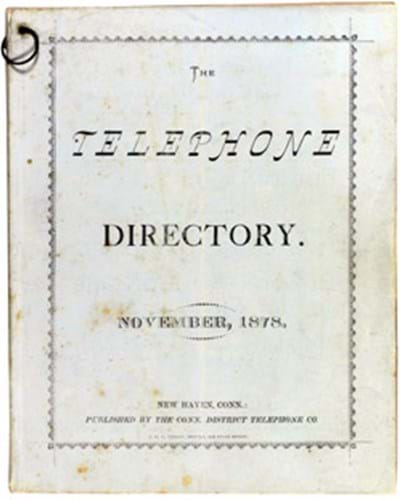
The 40pp booklet issued by the Connecticut District Telephone Company in November 1878 attracted an enormous amount of press coverage prior to the sale and on the day it sold to a US collector.
Stab-stitched in the original wrappers and retaining the metal suspension ring, it is generally considered the world's first telephone directory, although with some dissent from supporters of telephone books issued in Chicago and San Francisco.
The directory dates from only two years after the invention of the telephone. Indeed, the potential of Alexander Graham Bell's invention had been realised with enormous speed.
Within a year of his first intelligible transmission of a human voice in March 1876, the first newspaper report had been transmitted. In 1878, David Edward Hughes' invention of the microphone rendered the telephone commercially viable and July of that year saw the funding of the Bell Telephone Company, which retained patents for the issue of all telephones.
An inter-city line had been laid between Boston and New York in April 1877, but the first available commercial service was that launched in January 1878 in New Haven, Connecticut.
All wires were connected to a central office and as the Connecticut District Telephone Company explained in their first directory, some 400-500 subscribers had signed up in the first nine months and their wires now extended over 50 miles to different sections of the city and outlying districts.
In addition to technical directions for use of the various types of phone - the battery bell, push button and call bell phones - the pioneering Telephone Directory issued in New Haven offered the advice: "NEVER take the telephone off the hook unless you wish to use it... Should you wish to speak to another subscriber... you should commence the conversation by saying 'Hulloa!'. When you are done talking, say 'That is all!', and the person spoken to should say 'O.K'."
"Much trouble," the directory explained, "ensues from both parties speaking at the same time."
But what would modern subscribers make of this stern warning? "No subscriber will be allowed to use the wire for more than three minutes at a time, or more than twice in an hour, without first obtaining permission from the main office."
It was also advised that "any person using profane or otherwise improper language should be reported at this office immediately".
It is thought that a single-sheet list of about 50 names may have been issued in February, 1878, but no copies have been found and only one copy of the directory issued in November seems to have survived.
In 1981, as part of the magnificent Robert Honeyman sale of scientific books and manuscripts held at Sotheby's, it got only a scant, two-line entry in the catalogue and a £30-40 estimate. Even then, though, there were those who recognised its significance, it sold for £2800.
In 1996, it resurfaced at Christie's New York to sell for $18,000.
Now again, it was offered as part of a major collection, finding itself in very distinguished company as part of the Richard Green library of scientific books. The collection included works by Darwin, Galileo, Einstein and Copernicus - a copy of whose De revolutionibus orbium coelestium sold for close on $2m.
By Ian McKay




